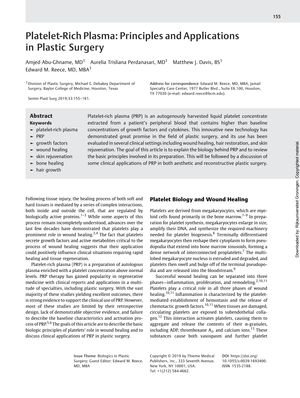Platelet-Rich Plasma: Principles and Applications in Plastic Surgery
August 2019
in “
Seminars in Plastic Surgery
”

TLDR Platelet-rich plasma is beneficial in various plastic surgery applications, but more research is needed to standardize its use.
The document reviews the use of platelet-rich plasma (PRP) in plastic surgery, detailing its role in wound healing, hair restoration, skin rejuvenation, tissue filling, bone regeneration, and pain management. PRP, which is rich in growth factors, has been shown to enhance neoangiogenesis, granulation tissue formation, and reduce healing time in wound care. It has also been associated with improved volume maintenance in fat grafting, except for breast fat grafting, and higher bone augmentation in bone grafts. For skin rejuvenation, PRP has been used successfully with microneedling and fractional laser, though its efficacy in facelifts is less clear. In hair restoration, PRP has demonstrated potential in promoting hair regrowth, particularly for conditions like androgenetic alopecia and alopecia areata, with multiple injections yielding significant results. The document stresses the need for standardized protocols and high-quality randomized controlled trials to further validate PRP's efficacy, despite it being a safe technology with no major side effects reported.







